A COMPOSITE GLIMPSE OF THE FUTURE
Page 52
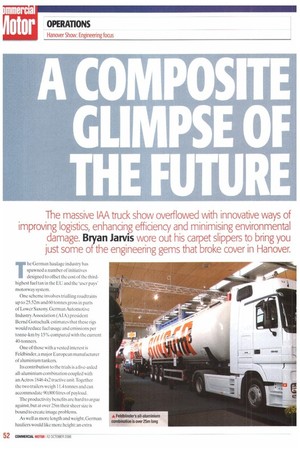
Page 53
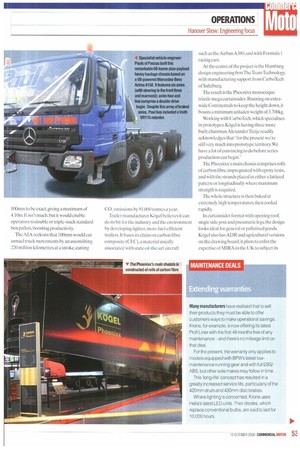
Page 54

Page 55
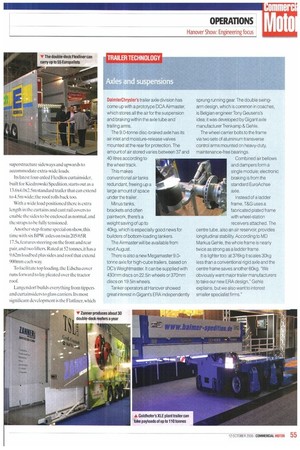
Page 56
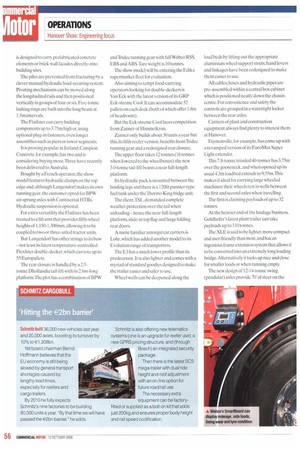
Page 57
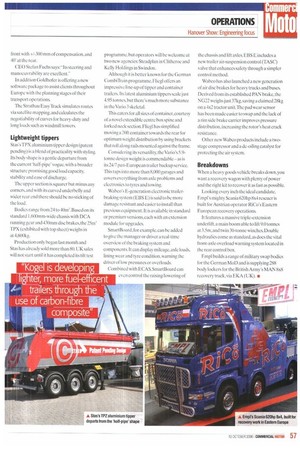
If you've noticed an error in this article please click here to report it so we can fix it.
The massive IAA truck show overflowed with innovative ways of improving logistics, enhancing efficiency and minimising environmental
damage. Bryan Jarvis wore out his carpet slippers to bring you
just some of the engineering gems that broke cover in Hanover.
The German haulage industry has spawned a number of initiatives designed to offset the cost of the thirdhighest fuel tax in the EU and the 'user pays' motorway system, One scheme involves trialling roadtrains up to 25.52m and 60 tonnes gross in parts of Lower Saxony. German Automotive Industry Association (A IA) president Bernd Gottschalk estimates that these rigs would reduce fuel usage and emissions per tonne-km by 15% compared with the current 40-tonners.
One of those with a vested interest is Feldbinder, a major European manufacturer of aluminium tankers.
Its contribution to the trials is a five-axled all-aluminium combination coupled with an Actros 1846 4x2 tractive unit. Together the two trailers weigh 11.4 tonnes and can accommodate 90,000 litres of payload.
The productivity benefits are hard to argue against, but at over 25m their sheer size is bound to create image problems.
As well as more length and weight. German hauliers would like more height: an extra 100min lobe exact, giving a maximum of 4.10m. It isn't much. but it would enable operators to double or triple-stack standard box pallets, boostin.g productivity.
The A IA reckons that 100mm would cut annual truck movements by an astonishing 220 million kilometres at a stroke, cutting CO2 emissions by 91,0(X) tonnes a year.
Trailer manufacturer Kogel believes it can do its bit for the industry and the environment by developing lighter, more fuel-efficient trailers, It bases its claim on carbon fibre composite (CFC), a material usually associated with state-of-the-art aircraft such as the Airbus A380, and with Formula 1 racing cars.
At the centre of the project is the Hamburg design engineering firm `The Team Technology, with manufacturing support from CarboTech of Saltzburg.
The result is the Phoenixx monocoque triaxle mega curtainsider. Running on extrawide Continentals to keep the height down, it boasts a minimum unladen weight of 3,700kg.
Working with CarboTech, which specialises in prototypes. Kogel is having three more built; chairman AlexanderTietje readily acknowledges that "for the present we're still very much into prototype territory:We have a lot of convincing to do before series production can begin.
The Phoenixx's main chassis comprises rolls of carbon fibre, impregnated with epoxy resin, and with the strands placed in either a latticed pattern or longitudinally where maximum strength is required.
The whole structure is then baked at extremely high temperatures. then cooled rapidly.
In curtainsider format with opening roof, single side post and pneumatic legs, the design looks ideal for general or palletised goods. Kagel also has APR and agricultural versions on the drawing board; it plans to enlist the expertise of MIRA in the UK to subject its
monocoque chassis to rigorous testing.
Initial production costs are likely to ramp up the price to twice that of a similar steel trailer and maybe 30% more than the aluminium equivalent.This is offset by the promise of an extended service life, as well as extra payload.
Kogel has achieved a full-strength neck which is just 40mm deep, plus a shallow (10mm) roof and a fifth-wheel coupling height of 950mm.There's a 3.0m ceiling height within Germany's 4.0m limit, and 2,600 litres of storage space below the main deck — enough to hold 36 pallets.Total load volume is I04.2m" plus another 720 litres of storage space in the front wall and 800 litres in the rear cabinet for a spare wheel, tools and the like.
And behind all that is an energy-absorbent rear under-run 'crash box'.
IT l is on familiar ground, having launched its first CFC trailer at the 2004 Hanover show. Working with the bodybuilder Meierling of Hagen, it helped produce a standard-spec 25m3 monocoque triaxled tipper with an incredible 3,600kg tare weight.
Over the past two years. says Meierling works manager Peteriakobi, it has carried sand, split and 3em stone daily, covering nearly 165,000km in the process with no sign of excessive wear and tear.
Another manufacturer interested in carbon fibre materials is Spitzer Silo, which specialises in tanker vessels. Using composites shaves 400kg off the weight of a comparable aluminium tank, but although five prototypes have been built it has yet to make any real sales breakthrough.
While CFC is a relatively new venture in CVs. Belgian trailer builder Composittrailcr has made considerable headway in the use of composites, principally of glass fibre and polyurethane resins.
As well as producing the fireproof Acrosoma body panel, it builds moving-floor trailers weighing as little as 5,850kg (40 sold to date): short (20ft) container chassis marketed by Renders; and flatbed trailers, Having switched to an integral neck design, it is also building three-axle boxvans (Colruyt is evaluating the first example) and staked timber flatbeds.
The Lokeren firm has also built many intermediate bulk containers (II3Cs); it recently forged an alliance with Martin Marietta Composites in America, allowing it access to Composittrailer technology.
Competitive edge
Builders of more conventional designs continue to review and improve their products to maintain that competitive edge.
Examples of this process at Hanover included1VIeusburger's range of trailers from flats to megas. Its tour de force is innovative plant and machinery trailers featuring hydraulic actuation to extend the
superstructure sideways and upwards to accommodate extra-wide loads.
Its latest four-axled FlexBox curtainsider, built for Kiedrowski Spedition, starts out as a 13.6x4.0x2.5m standard trailer that can extend to 4.5m wide; the roof rolls back too.
With a wide load positioned there is extra length in the curtains and cant rail covers to enable the sides to be enclosed as normal, and the straps to be fully tensioned.
Another step-frame special on show, this Lime with six BPW axles on twin 205/65R I 7.5s, features steering on the front and rear pair, and two lifters. Rated at 52 tonnes, it has a 9.62m loadbed plus sides and roof that extend 900mm each way.
To facilitate top loading. the Edscha cover runs forward to lay pleated over the tractor roof.
Langendorf builds everything from tippers and curtainsiders to glass carriers. Its most significant development is the Flatliner, which is designed to carry prefabricated concrete elements or brick wall facades directly onto building sites.
The piles are prevented from fracturing by a clever manual/hydraulic load-securing system. Pivoting mechanisms can be moved along the longitudinal rails and then positioned vertically in groups of four or six. Five-tonne lashing rings are built into the long beam at 1.5m intervals.
The Flatliner can carry building components up to 3.75m high or, using optional plug-in fasteners, even longer assemblies such as piers or tower segments It is proving popular in Ireland; Campion Concrete. for example, has two and is considering buying more.Three have recently been delivered to Australia.
Bought by a French operator, the show model features hydraulic clamps on the top edge and, although Langendorf makes its own running gear, the customer opted for BPW air-sprung axles with Continental HTRs. Hydraulic suspension is optional.
For extra versatility the Flatliner has been treated to a lift arm that provides fifth-wheel heights of 1,150-1,300mm, allowing it to be coupled to two or three-axled tractor units.
But Langendorf has other strings to its bow — not least its latest temperature-controlled Flexliner double-decker, which can tote up to 55 Europallets.
The rear closure is handled by a 2.5tonne Dhollandia tail-lift with its 2.6m-long platform.The plot has a combination Of BPW and Tridec running gear with full Wabco RSS, EBS and ABS. Tare weight is 10 tonnes.
The show model will be entering the Edika supermarket fleet for evaluation.
Also aiming to tempt food-carrying operators looking for double-deckers is Van Eck with the latest version of its GRP Eck-streme Cool. It can accommodate 52 pallets on each deck (both of which offer 1.8m of headroom).
But the Eck-strerne Cool faces competition from Zanner of Himmelkron.
Zanner only builds about 30 units a year but this, its fifth reefer version. benefits from Tridec running gear and a redesigned rear closure.
The upper floor takes 12 tonnes (16 tonnes when lowered to the wheelboxes); the new 3.0-tonne tail-lift boasts a near full-length platform.
Its hydraulic pack is mounted between the landing legs and there is a 1201it pannier-type fuel tank under the Thermo King fridge unit.
The client,TSL, demanded complete weather protection over the tail when unloading— hence the near full-length platform, slide-in top flap and large folding rear doors.
A name familiar amongst car carriers is Lohr, which has added another model to its Evolution range of transporters The E3 has a much lower profile than its predecessor. It is also lighter and comes with a myriad of standard goodies designed to make the trailer easier and safer to use.
Wheel wells can be deepened along the load beds by lifting out the appropriate aluminium wheel support struts; hand levers and linkages have been redesigned to make them easier to use.
All cables, hoses and hydraulic pipes are pre-assembled within a central box cabinet which is positioned neatly down the chassis centre. For convenience and safety the controls are grouped in a watertight locker between the rear axles.
Carriers of plant and construction equipment always find plenty to interest them at Hanover.
Faymonville, for example, has come up with a revamped version of its EuroMax Super Light extender.
This 7.8-tonne triaxled 40-tonner has 3.75m over the gooseneck, and when opened up its usual 4.3m loadbed extends to 9.55m. This makes it ideal for carrying large wheeled machines: their wheels rest in wells between the first and second axles when travelling.
The firm is claiming payloads of up to 32 tonnes.
At the heavier end of the haulage business, Goldhofer's latest plant trailer can take payloads up to 110 tonnes.
The XLE is said to be lighter, more compact and user-friendly than most, and has an ingenious frame extension system that allows it to be converted into an extremely long loading bridge. Alternatively it tucks up nice and close for smaller loads or when running empty.
The new design of 12-14-tonne swing (pendular) axles provide 70'of steer on the front with +/-3(X) mm of compensation, and 40' at the rear.
CEO Stefan Fuchs says:"Its steering and manoeuvrability are excellent."
In addition Goldhofer is offering a new software package to assist clients throughout Europe with the planning stages of their transport operations.
The Stratbau EasyTrack simulates routes via satellite mapping, and calculates the negotiability of curves for heavy-duty and long loads such as windmill towers.
Lightweight tippers
Stas's TPX aluminium tipper design (patent pending) is a blend of practicality with styling. Its body shape is a gentle departure from the current 'half-pipe' vogue, with a broader structure promising good load capacity, stability and ease of discharge.
The upper section is squarer but minus arty corners, and with its curved underbelly and wider rear end there should he no sticking of the load.
Bodies range from 24 to 40m3. Based on its standard 1,6(X)mm-wide chassis with DCA running gear and 430mm disc brakes, the 25m' TPX (exhibited with top sheet) weighs in at 4,600kg.
Production only began last month and Stas has already sold more than 80. UK sales will not start until it has completed its tilt test programme. but operators will be welcome at two new agencies:Steadplan in Clitheroe and Kelly Holdings in Swindon.
Although it is better known for the German CombiTrain programme, Fliegl offers an impressive line-up of tipper and container trailers. Its latest aluminium tippers scale just 4.95 tonnes, but there's much more substance in the Vario 3 skeletal.
This caters for all sizes of container, courtesy of a novel extendible centre box spine and forked neck section. Fliegl has simplified moving a 20ft container towards the rear for optimum weight distribution by using brackets that roll along rails mounted against the frame.
Considering its versatility, the Vario's 5.9tonne design weight is commendable —as is its 24/7 pan-European trailer backup service. This taps into more than 8010 garages and covers everything from axle problems and electronics to tyres and towing.
Wabco's E-generation electronic trailerbraking system (EBS E) is said Lobe more damage resistant and easier to install than previous equipment. It is available in standard or premium versions,each with an extension module for upgrades.
Smart Board, for example, can be added to give the manager or driver a real-time overview of the braking system and components. It can display mileage, axle loads, lining wear and tyre condition, warning the driver of low pressures or overloads.
Combined with ECAS,SmartBoard can even control the raising/lowering of the chassis and lift axles. EBS E includes a new trailer air-suspension control (TASC) valve that enhances safety through a simpler control method.
Wabco has also launched a new generation of air disc brakes for heavy trucks and buses. Derived from its established PAN brake, the NG22 weighs just 37kg, saving a claimed 28kg on a 4x2 tractor unit.The pad wear sensor has been made easier to swap and the lack of a rim side brake carrier improves pressure distribution, increasing the rotor's heat crack resistance.
Other new Wabco products include a twostage compressor and a de-oiling catalyst for protecting the air system.
Breakdowns
When a heavy goods vehicle breaks down, you want a recovery wagon with plenty of power and the right kit to recover it as fast as possible.
Looking every inch the ideal candidate, Fmpl's mighty Scania 620hp 8x4 rescuer is built for Austrian operator RiCo's Eastern European recovery operations.
It features a massive triple-extension underlift, a main boom able to lift 9.0 tonnes at 3.5 m,and twin 30-tonne winches. Double hydraulics come as standard, as does the vital front-axle overload warning system located in the rear control box.
F,mpl builds a range of military swap bodies for the German MoD and is supplying 288 body lockers for the British Army's MAN 8x8 recovery truck, via EKA (UK). •










































































































































































































